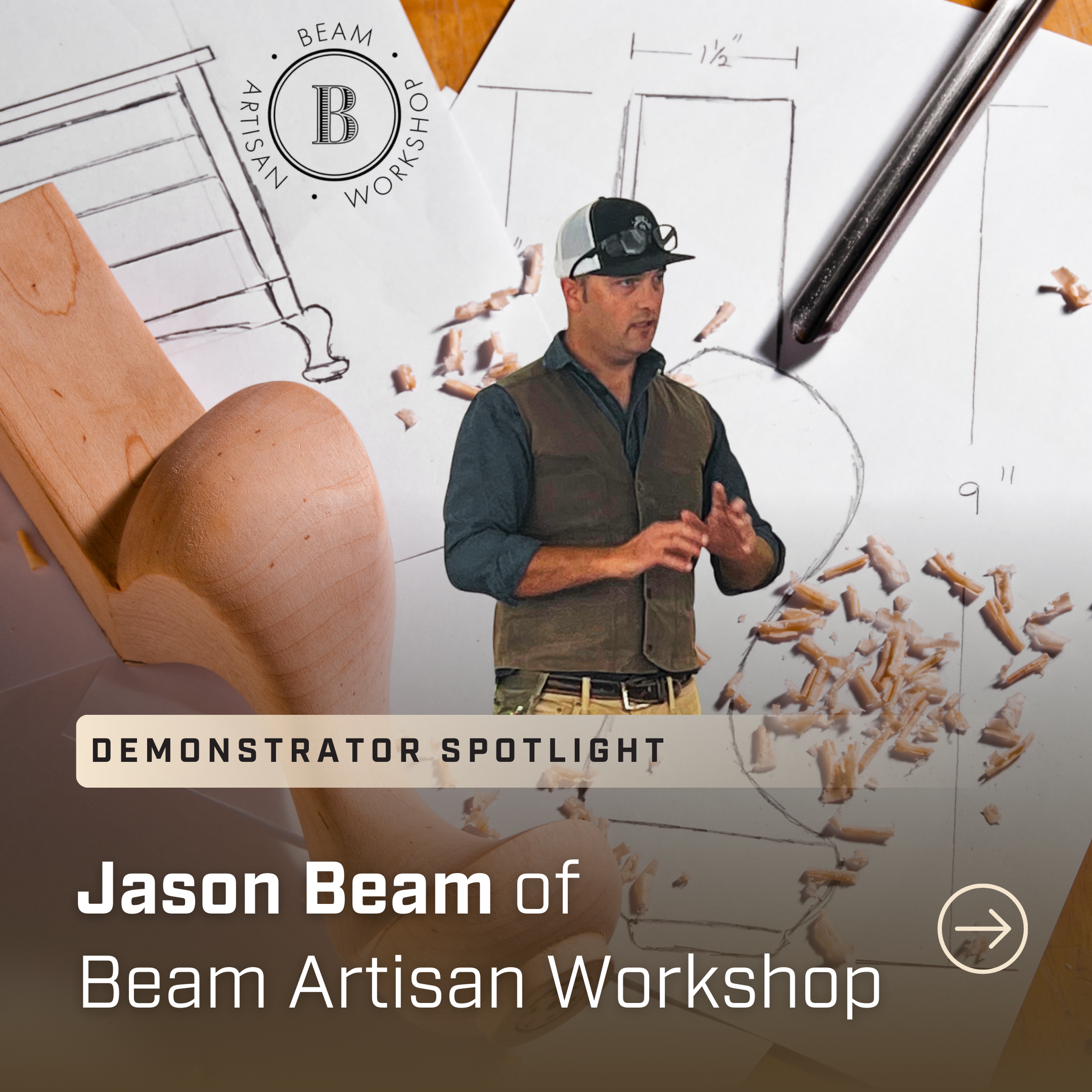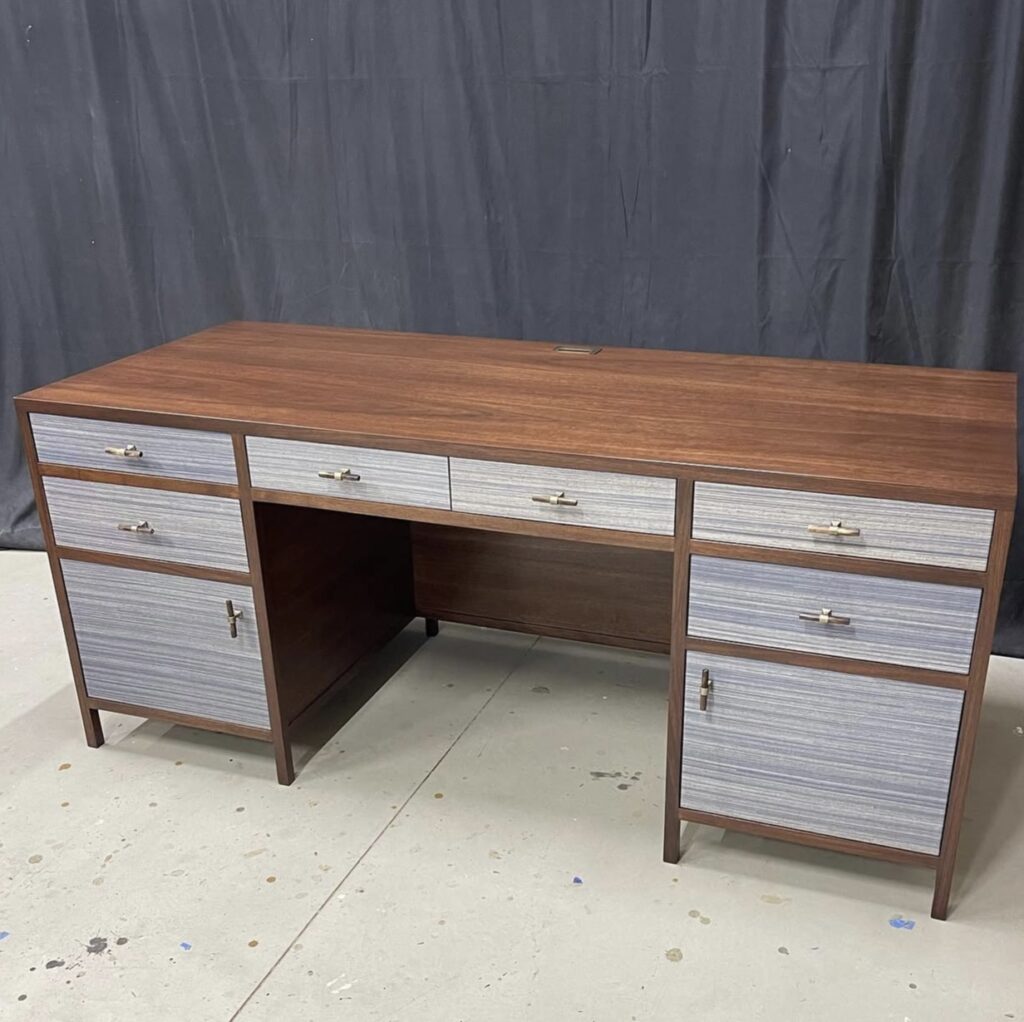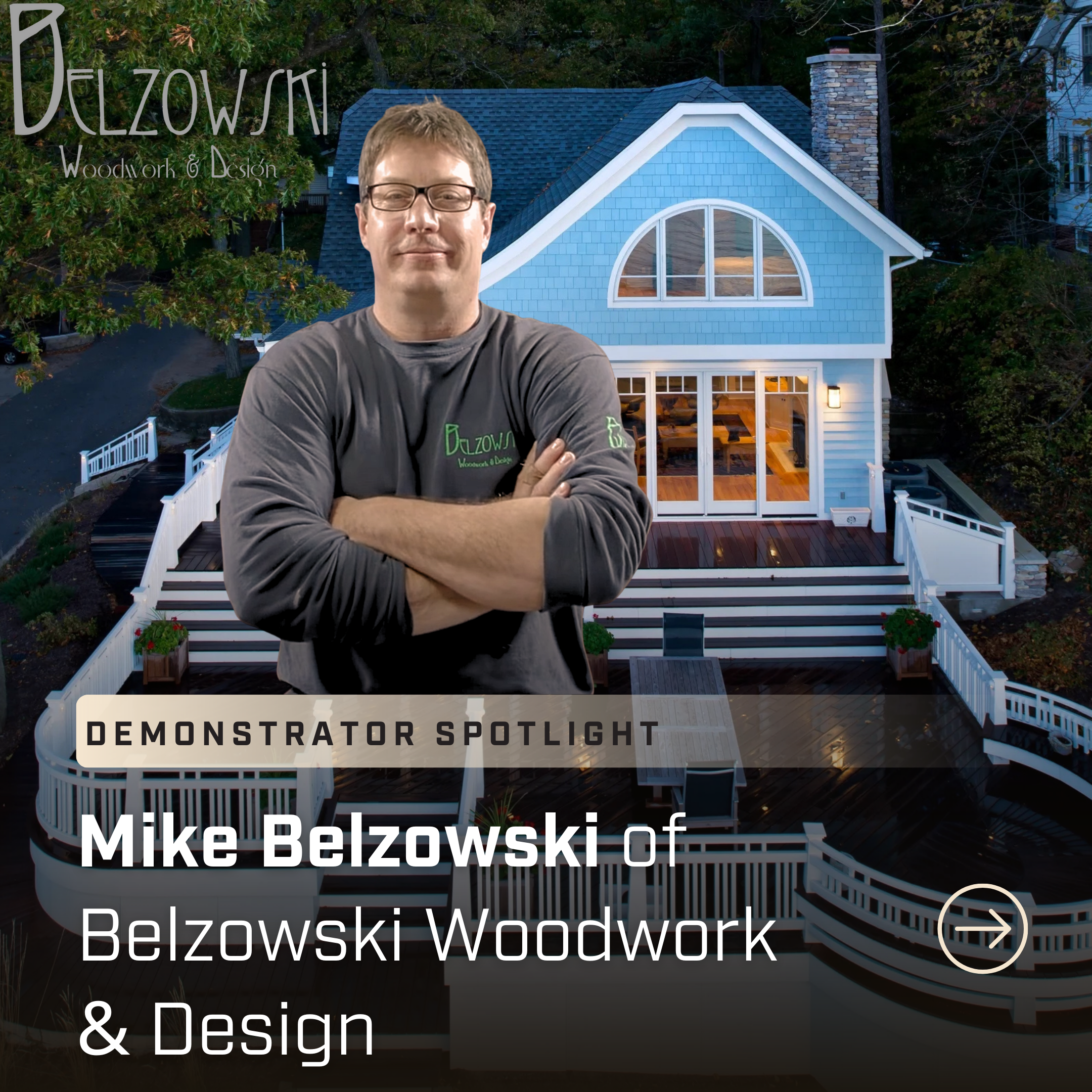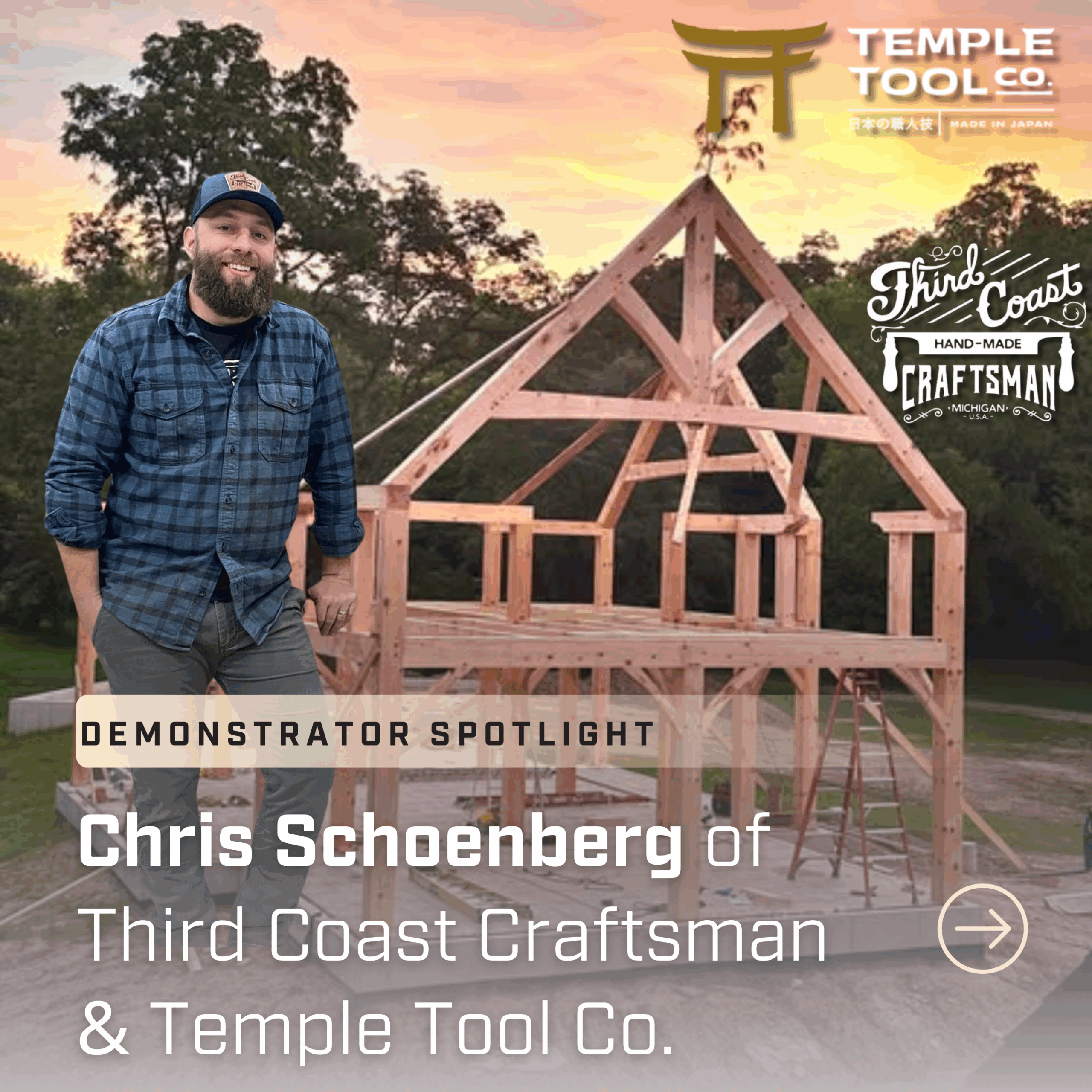Blogs
Demonstrator Spotlight: Jason Beam

Owns Beam Artisan Workshop and Creates Custom Pieces for Clients
Woodworking is more than just a skill or career: it’s a blend of many things–hard work, patience, and passion. This is the second edition of our Demonstrator Spotlight segment to lead up to our annual shows: Johnson’s Wood Expo (Charlotte, MI) and Johnson’s Woodworking Showcase (South Bend, IN). This year both are taking place in September.
We have been interviewing demonstrators and getting the inside scoop on how they got started in woodworking. This edition focuses on Jason Beam, who’s based in Olivet, MI. He creates custom pieces through his brand, Beam Artisan Workshop. He was introduced to woodworking by his uncle five years ago. He shared with us his story, how he got involved in the trade, why he values handcrafted furniture, and what he hopes attendees at EXPO will take away from the event this year.
Q&A with Beam
Q: Can you tell us a little bit about yourself and the type of woodworking you do?
A: Jason has lived in Olivet his whole life, and his business is based there as well. “I kind of almost fell into the profession,” says Beam. His uncle had a company called Joseph Beam Custom Woodwork. Joseph Beam was in the custom furniture business for 25 years and was looking to take a step back. He made custom furniture; his main clients were designers, mostly from New York City. One in particular, whom Jason still works with today, is Cullman & Kravis. Jason joined his uncle to build custom pieces that these designers couldn’t find, whether from a vendor, in a showroom, or a size, shape, or finish that differs from an existing piece.
Beam began his career driving back and forth to St. Joseph, MI, where his uncle’s business was located. There, he worked alongside him in his shop, learning his methods, how to run the business, deliver pieces, and speak with clients. After one year, he had built one piece for a client, but his uncle sent out an email saying Jason would be taking over. Jason was successful in retaining many of the clients, a list he has since expanded over the last five years.
Interested buyers and designers can view pieces on his Instagram (@beam_artisan_workshop), which acts as a catalogue of past projects. Beam works with designers on materials, style, and size. He creates technical drawings by hand on a 1920s drafting table that his grandfather owned. “A lot of people these days use computer programs to design everything, and I think it’s kind of cold and impersonal,” says Beam. “I have always really enjoyed drafting, and my uncle did everything with a pencil on paper as well. I think it’s something the clients appreciate too, because the actual drawing is a piece of artwork in itself.” He provides clients with technical drawings and finishing samples before he begins building, and everything is one flat rate, meaning he does as many drawings, samples, and alterations until the client is happy with the result.
“Every aspect of the piece, from the concept to its delivery, is done by me,” says Beam. “I deliver around 95% of my stuff, but I will sometimes have to pack freight or have white glove companies pick it up.” If something does get damaged in transit, Beam has a plan for that and has made repairs before. “It’s just part of the business. I’ll tie a repair in with a delivery and either pick a piece up and bring it home or try to repair it on-site if I’m able,” says Beam, “But luckily, I haven’t had to do a whole lot of repairs.” He says that there can be headaches associated with the business when things don’t go as planned, but that it’s a wonderful job and he’s super blessed to do it.
Q: Do you remember what your first big project was?
A: The first piece Beam made was for a designer. His uncle had several pieces he was doing for this client, and gave one to him. It was a demilune, which is a crescent-shaped half-round table, for an entry table in a Wisconsin home. He recalls it being pretty tough for his first piece. “I remember that they had sent an image of what they were looking for, and I drew exactly what the image looked like. That’s when I learned it’s often open for interpretation,” says Beam, “I can make subtle changes to ensure it fits the piece better.” His uncle gave him constructive feedback on his first drawing and ended up making the piece much better.
Q: Do you feel like you have your own style even though you make commissioned pieces?
A: “I don’t have a niche or a style and the work I do is very broad,” says Beam, “I do woodworking and I do all my own custom metal work as well: metal fabrication, brass and bronze, custom patina, metal finishes, that kind of stuff.”

As an example of the wide range of products he makes, he showed us a custom cabinet with horse hair fabric (see above). He had received a request from a client who wanted to incorporate it into the piece, so the sides and the front panels have it. “Most of the requests I get from clients I’d never done before, so I have to then figure it out,” says Beam, “That’s just part of the job, it’s very much rooted in finding solutions to problems.
When he encounters a unique request like the horse hair cabinet, the client will have to source the materials, and it will be included in the estimate. “Clients are interested in textures, colors, what the material is going to do for the piece, and how it works together in a space. Generally, I wouldn’t be asked to source the materials because they’re very particular,” says Beam. He enjoys working with clients and tackling their interesting requests; it keeps him on his toes.
Q: How long do projects typically take you to complete?
A: Beam said it’s hard to say how long a typical project takes him because he works on more than one at a time. He currently has 16 pieces that he’s working on, ranging from not having started their drawing to being nearly completed. He admitted that he’s very disorganized but that his process works for him and he’s learned to appreciate how his brain works.
Q: Do you have a favorite wood to work with?
A: The woods he works with the most are walnut and oak. “I love both, and they each have very different qualities about them,” says Beam. Ultimately, he said it depends on the piece he’s making. For instance, if he had to turn something, he would want to use walnut over oak, because oak can be tricky to turn. “I don’t know if I have a favorite,” says Beam, “I work with mahogany quite a bit, but white oak and walnut are king right now. That’s kind of what everything is being built with.”
Q: Where do you find inspiration for work, even though a lot of it is commissioned?
A: A lot of inspiration for his pieces is given to him. While he does enjoy the artistic aspect of drawing and creating the pieces, he feels that it’s nice not having to completely design every piece for every client. “It makes it a lot simpler for me in terms of running a business.”
Despite creating many unique pieces that can oftentimes be strange as standalone pieces outside of a room, Beam is proud of every piece he’s worked on. “There’s never been a piece that I haven’t wanted others to see because I trust my clients and I know that they know what they’re doing,” says Beam.
Q: If someone were to look for a Beam Artisan piece, do you have your name stamped inside somewhere?
A: Beam admits that he’s really bad at remembering to mark pieces, so not all of his work is marked, especially some of the earlier pieces. He wants to make a point to get better at that. Despite forgetting to mark pieces sometimes, he does have a stamp, but would like to make plates as well. “My uncle had these nice brass plates that he’d put on everything,” says Beam, “One of his pieces came up in a Sotheby’s auction, and they contacted him and talked to him about the piece.”
Q: Do you have any advice for someone who wants to start making custom furniture of their own or do any kind of woodworking?
A: Beam said he had a student from Olivet who wanted to be a woodworker and approached him. He would come to his shop regularly for a few years. He said he made beautiful pieces, and he was able to teach him new skills. “My advice to him was always to just go for it. Don’t be afraid to try something or mess up. I mess up all the time and am constantly repairing things, fixing mistakes that I made, or miscalculations. It’s the nature of the job, and it’ll always be like that,” says Beam.
“My uncle, who’d been doing it for 25 years, still made mistakes, so you can’t be afraid to dive in and go for it,” Beam said. He did just that when choosing to pursue woodworking full-time and quit his job. He emailed clients saying that he was going to be taking over and making furniture, even though he hadn’t yet done it on his own. “It was a big gamble for me. I felt confident enough to do it, so I just had to go for it.”
Now, when a client asks him to build a cabinet covered in horse hair fabric, he says yes and figures it out even though he’s never done it before. “You’re going to fail and you might have issues, but if you have any motivation, then you’ll probably figure it out,” says Beam, “That’s what I did.”
Q: Where do you turn for guidance if you encounter something that you don’t know how to do?
A: Beam says it boils down to 10% YouTube and 90% experimentation. “I have a pretty good understanding of materials and adhesives and their qualities, so I can often figure it out from there,” says Beam, “Then, you have to make sure there’s time to figure things out before you have to build the piece and get it delivered to the client.”
Beam shared that he recently made a birch bark cabinet with willow twig trim for a client in Utah. He said he had to figure out how to glue birch bark to plywood and did so through experimentation. “My first press worked perfectly and all the presses went great, so I had no issues with it,” says Beam, “You never know, sometimes you figure it out on the first try, and sometimes it takes more time and energy.”
Q: Do you have any employees or ambitions to grow your shop?
A: Beam said his friend Levi has helped him throughout the years and does a lot of design for his social media and website. Lately, it’s just been himself, and he doesn’t intend to hire anyone anytime soon. He loves the simplicity of it, just being him. “ I love the boutique feel and having the intimate relationships that I have with my clients. Things like that tend to get lost when companies get huge,” says Beam.
He also doesn’t want to skimp on quality and likes overseeing the building process, but doesn’t know how much leeway he could give if someone else were working on a project. “It’s not to say that there aren’t a lot of awesome craftsmen out there that would do a wonderful job, but when I’ve been hired to do something, I feel like it’s my job to make sure it’s done the way I want it to. I feel like I would be giving a lot of that up if I were to hire somebody else,” says Beam. He always keeps busy and has never really had the feeling of wanting more. “I’m just 100% content with everything right now.”
Q: With your presentation at this year’s EXPO, is there something that you would like attendees to take away?
A: The biggest thing Beam wants people to take away from his demonstration, other than the basic knowledge he’s sharing, is that the concept he’s trying to teach is not over their heads. “None of it is too difficult for you to attempt,” says Beam, “Any one of them could go get the tools that I have, you might have to invest a little bit of money, time, and energy, and make a piece.”
He has always believed in going for something, whether it’s learning a new skill or tackling a project you’ve never done before, and trying it out even if it takes you several times to get it right. He says if you try it out and adapt, you’ll eventually find that you’re able to do it. At some point, you’ll stop messing it up and you’ll be able to do that. “No one should feel like it’s intellectually above their ability or outside their talent,” says Beam, “You can go at your own speed, choose the size of the piece you want to make, and start with something simple, as opposed to jumping into a massive woodworking project.”
Q: What’s your favorite part of EXPO?
A: Beam recalls his favorite part of last year’s event was listening to Mike Belzowski and his steam-bending presentation. “I’m waiting for a project to come along where I get to try my hand at steam bending. So, demonstrations are usually what I enjoy most and being able to see interesting things that I haven’t been introduced to yet,” says Beam.
Jason Beam has a clear passion for woodworking and designing custom pieces for people looking to add beautiful, handcrafted furniture to a space. You can follow along with his content under the handle @beam_artisan_workshop on social media.
Want more stories like this one? Subscribe to our newsletter or check out our other blog posts at lljlumber.com/blogs/. Visit LLJLumber and TheWorkbench for more updates and information about Johnson’s Wood EXPO and Woodworking Showcase.


